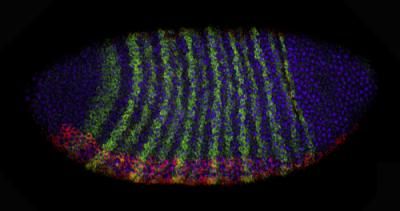Urgent! How genes tell cellular construction crews, 'Read me now!'
When egg and sperm combine, the new embryo bustles with activity. Its cells multiply so rapidly they largely ignore their DNA, other than to copy it and to read just a few essential genes. The embryonic cells mainly rely on molecular instructions placed in the egg by its mother in the form of RNA.

The dorsal-ventral patterning gene snail (shown in red) is one of the few genes that are active before as well as after the midblastula transition. The segmentation gene paired (shown in green) is turned on during the transition. Cell nuclei are shown in blue.
Courtesy of Kai Chen
The cells translate these RNA molecules into proteins that manage almost everything in the first minutes or hours of the embryo's life. Then, during the so-called midblastula transition, cells start transcribing massive amounts of their own DNA. How embryonic cells prepare for this moment, and how they flag a small set of genes for transcription before that, holds important information about normal development and disease in animals and in humans.
A new study that sheds light on these questions appears in the issue of eLife Sciences, authored by researchers at the Stowers Institute for Medical Research. The team, led by Associate Investigator Julia Zeitlinger, Ph.D., shows that in the fruit fly Drosophila melanogaster, genes active in the first two hours of a fertilized egg are read quickly due to special instructions at the beginning of each gene, in a region aptly named the "promoter."
Within each promoter region, different combinations of short control elements or "boxes" form a code that instructs specialized construction crews, called RNA polymerases, where and when to start transcribing. Researchers long thought that once an RNA polymerase appears at the worksite it would quickly finish the job.
"The most important result is that promoters are different," Zeitlinger says. "The general paradigm for a long time has been a promoter is a promoter. But really what we see is that they have different functions."
As a postdoctoral fellow at MIT, Zeitlinger unexpectedly discovered that sometimes RNA polymerase II pauses at the beginning of a gene as if taking a lunch break. More often than not, pausing occurred at genes important for development. Zeitlinger thought pausing may help get these molecular construction workers on site before a huge work order is due.
"We were wondering whether pausing was being used for preparing global gene activation during the midblastula transition," says Kai Chen, PhD, a former graduate student in Zeitlinger's lab and the study's first author. "We expected to see widespread pausing before that transition."
The fruit fly Drosophila melanogaster was a perfect test subject. This fly embryo takes two hours to reach the midblastula transition providing plenty of time to analyze what happens during this early period. Furthermore, decades of previous research on the flies provided context to guide the work.
Chen used a method called ChIP-seq, which can locate RNA polymerase II molecules on any gene. Paused polymerases would show up only at the beginning of genes. Working polymerases, on the other hand, would be found throughout the gene body.
The results took the Stowers team by surprise. Before the midblastula transition, RNA Polymerase II appeared to rarely pause as it transcribed roughly 100 early genes. And no construction crews were sitting idle on inactive genes in preparation for the midblastula transition. Pausing only became widespread only during the midblastula transition itself.
"What we found was not what we expected at all," Zeitlinger says. Before the midblastula transition, instead of preparing for a huge workload the construction crews were busy completing rush jobs. "The polymerase has to come to the promoter and immediately transcribe because there's so little time to do the job. That's one way of making transcription faster. "
When Chen and colleagues computationally compared the DNA sequences of promoters where pausing occurred with those where it didn't, a pattern emerged. They found that three different types of promoters correlated with the construction crew's pausing behavior.
The genes that RNA Polymerase II reads before the midblastula transition were often preceded by a promoter that seemed to yell, "Urgent! Don't even think about pausing." These promoters contain what's known as a TATA-box, named for its conserved arrangement of nucleotides, most commonly TATAA.
As cell division slows down during the midblastula transition, cells have the luxury of pausing, perhaps to fine-tune when transcription begins, Zeitlinger says.
These midblastula genes were regulated by promoters that contain a variety of specific promoter elements associated with paused RNA polymerase, including GAGA, Downstream Promoter Element (DPE), Motif Two Element (MTF) and Pause Button (PB).
The team also found a third type of promoter, which contained both the TATA-box and the pausing sequences. At these genes, RNA polymerase II does not pause initially but begins to pause during the midblastula transition.
Zeitlinger hopes learning more about promoters will give clues to the functions of unknown genes. Because these promoter sequences are not specific to flies, the differences among promoter types may be conserved in other animals as well.
"My lab is interested in understanding how development or even diseases are encoded in the genome," Zeitlinger says. "If we understand transcription, then we can predict a lot of what genomes encode, in terms of disease or differences between individuals."
"Promoters had been seen by some scientists as sort of boring," she adds, "but now, they are starting to get really interesting."




















































